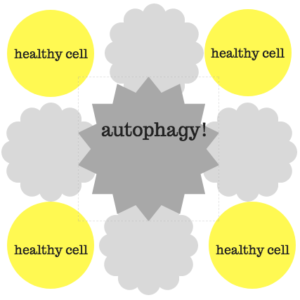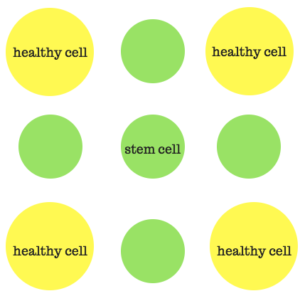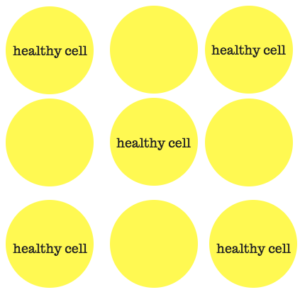In the past I used to suffer from “hanger”, feeling hungry and irritable if going more than a few hours without food. Now my body is adapted to fasting, going prolonged periods without food—and I feel all-the better for it.
 When I was a kid, no one ever had to convince me to finish my dinner. Perpetually “hangry” (hungry and angry), I was the Tasmanian devil of snacking, vacuuming up whatever food substances crossed my path, leaving wrappers and crumbs in my wake. “Never get between Talia and her food,” my brother facetiously coined when, like a voracious bull, I would bully my way into the kitchen to fix myself an emergent after-school snack. From the moment I was born, it seems, going more than two hours without eating was a physical impossibility. “I’m sick with hunger,” I would complain whenever my blood sugar levels dipped.
When I was a kid, no one ever had to convince me to finish my dinner. Perpetually “hangry” (hungry and angry), I was the Tasmanian devil of snacking, vacuuming up whatever food substances crossed my path, leaving wrappers and crumbs in my wake. “Never get between Talia and her food,” my brother facetiously coined when, like a voracious bull, I would bully my way into the kitchen to fix myself an emergent after-school snack. From the moment I was born, it seems, going more than two hours without eating was a physical impossibility. “I’m sick with hunger,” I would complain whenever my blood sugar levels dipped.
Now I sit here writing this article, in my adult incarnation, comfortably having abstained from eating for more than 14 hours. Whereas before I couldn’t go more than 2 hours without some kind of sugary snack, my body is now adapted to thriving during prolonged periods without food—and I feel all-the better for it.
“Eat a snack every 2-3 hours to keep blood sugar stable and lose weight,” dieticians and nutritionists often advise . However, as we dig into the disease prevention, anti-aging and weight management research, we learn that there may be benefits to going without food for prolonged periods.
We humans spent much of our evolutionary history hunting and gathering with extended periods of food scarcity. Our bodies adapted to survive through, and perhaps even thrive and depend on, periodic fasts. We now live in a society that enjoys food abundance: with 24-hour convenience stores and fast food restaurants at our disposal, we rarely go hungry. This recent lifestyle change may contribute to the increase in the diseases of excess that afflict modern bodies.
Ancient healing systems like Ayurvedic medicine and Traditional Chinese Medicine have long recognized the benefits of fasting for purifying and healing the body. Today, a body of research is accumulating that suggests that fasting may help treat diseases like multiple sclerosis and cancer, reduce the risk of chronic metabolic diseases, such as diabetes, battle dementia and cardiovascular disease, and reverse the effects of aging, helping us live longer.
What Happens During Fasting:
Human physiology fluctuates between two modes: the fasted and the fed state. After eating, a hormone called insulin rises in response to the intake of dietary carbohydrates and, to a lesser extent, protein. Insulin allows glucose to enter cells where it can be used for energy. Insulin encourages the storage of body fat and glycogen—a molecule stored in the muscles and liver that can be broken down quickly for energy. Insulin is an anabolic hormone that promotes tissue building and growth.
Our bodies are in the fed state, or postprandial state, for up to 4 hours following a meal, when blood sugar and insulin levels rise and the body begins to store food energy. 4-6 hours after eating, our bodies enter the post-absorptive state. Insulin and blood sugar levels fall, and blood sugar is maintained through the breakdown of liver and muscle glycogen. At the 10-12 hour mark post-meal, the body enters the fasting state. At this stage, glycogen stores have been depleted and blood glucose is maintained through a process called gluconeogenesis: glucose is created from fat, lactate and protein. In the fasting state, the body taps into fat stores to create ketone bodies, which are used for fuel.
Approximately 24-48 hours after a meal, the body enters a state called autophagy (or self-eating). The body breaks down old, damaged cells into their proteins and reuses them to build new cells or for fuel, through gluconeogenesis. Autophagy has gained the attention of researchers who recognize its benefits for managing inflammation, slowing the effects of aging, and treating various chronic diseases, such as autoimmune disease and cancer—more on this later!
Fasting to Treat Cancer:
Valter Longo, PhD, at the Longevity Institute at the University of Southern California, examined the effects of 2 to 4-day fasts on patients with cancer who were undergoing chemotherapy. The study found that several days of fasting improved the efficacy of chemotherapy, while reducing its side effects, protecting healthy, non-cancerous cells. Healthy cells responded to the periods of food restriction by shutting down, protecting them from the toxicity of the chemotherapy. Cancer cells don’t have such a response, leaving them susceptible to the chemotherapy. “Cancer cells are dumb cells,” says Dr. Longo.
The fasting period not only improved the effects of cancer treatments, it stimulated the regeneration of the immune system through the creation of progenitor stem cells. Fasting cleared out damaged immune cells and cancer cells through autophagy and new cells were regenerated upon re-feeding. Dr. Longo and his team found that up to 40% of the immune system is rebuilt in mice after a fasting and re-feeding cycle.
Fasting Mimicking Diets:
Recognizing the difficulty in going 3 days without food, Dr. Longo developed a 5-day “Fasting Mimicking Diet” that allows for the consumption of about 700-1000 calories per day in the form of small snacks. The Fasting Mimicking Diet is low enough in calories, protein and carbohydrates to mimic the physiological conditions and benefits of fasting like autophagy, ketone body production, beneficial stress response, and cancer cell starvation.
Mice given the Fasting Mimicking Diet (FMD) lost 30% of their body weight through the breakdown of body fat and clearing away of old, damaged cells. When the mice were re-fed, their blood, brain and bone cells were rebuilt. The mice who underwent the Fasting Mimicking Diet had rejuvenated immune systems, decreased incidences of cancer, reduced body fat, improved cognitive performance, decreased inflammation, and increased lifespans.
Fasting to Treat Autoimmunity:
Research in mice showed promising results in using the Fasting Mimicking Diet to treat multiple sclerosis, a debilitating autoimmune condition that attacks the nervous system. When following the diet, immune cells that were attacking the brain and spinal cord were destroyed. Upon re-feeding, new progenitor stem cells were created that repopulated the immune systems of the affected mice, and aided in repairing the damage to the brain and spinal cord. The Fasting Mimicking Diet resulted in a 20% reduction in autoimmunity in mice with multiple sclerosis.
A study that examines the effects of the Fasting Mimicking Diet on humans with Crohn’s Disease, an autoimmune disease the affects the digestive system, are currently underway.
Fasting to Reverse Aging:
 Autophagy, the process of removed and recycling old and damaged cells, is a new area of research for reversing the effects of aging. Autophagy alleviates the body burden of senescent cells that have stopped dividing but are still robbing the body of essential nutrients and energy.
Autophagy, the process of removed and recycling old and damaged cells, is a new area of research for reversing the effects of aging. Autophagy alleviates the body burden of senescent cells that have stopped dividing but are still robbing the body of essential nutrients and energy.
When cells become senescent, they release inflammatory mediators, which can damage neighbouring cells and cause inflammation and disease. Cellular senescence is thought to be one of the primary mechanisms by which we age. As we age, more cells become senescent, causing age-related inflammation. A study found that inflammation is the primary factor that drives the aging process, damaging DNA and contributing to various diseases, such as cardiovascular disease, diabetes, arthritis, cancer, and autoimmunity.
 The process of fasting and re-feeding stimulates the production of new, healthy progenitor stem cells in the immune system. Mice and human volunteers who underwent cycles of the Fasting Mimicking Diet had decreased numbers of myeloid cells, the inflammatory immune cells that become more numerous as we age, and increased numbers of cytotoxic T cells, which protect the body against viruses and cancer.
The process of fasting and re-feeding stimulates the production of new, healthy progenitor stem cells in the immune system. Mice and human volunteers who underwent cycles of the Fasting Mimicking Diet had decreased numbers of myeloid cells, the inflammatory immune cells that become more numerous as we age, and increased numbers of cytotoxic T cells, which protect the body against viruses and cancer.
Fasting promotes longevity through its inhibition of Insulin-like Growth Factor -1 (IGF-1), a growth factor that promotes cellular growth, and prevents the death of senescent cells. Growth factors are important for growing babies and children, developing fetuses, boosting muscle, and growing new brain cells. However, growth factors like IGF-1 are negatively associated with longevity because of their potential to stimulate the growth of cancer and prevent autophagy. Mice whose growth factor-dependent genes were removed, or “knocked out”, lived 40-50% longer and suffered from less diseases as they aged. IGF-1 is stimulated by protein and carbohydrate intake; it is elevated in the fed state and inhibited when fasting.
 Healthy humans who underwent cycles of the Fasting Mimicking Diet had lower risk factors that were associated with cardiovascular disease and diabetes, such as lowered blood pressure, reduced CRP (a marker of inflammation in the blood), and reduced fasting blood glucose levels. These markers remained improved even after the subjects returned to a normal diet, which indicates that fasting may help reduce the risk of chronic diseases, such as diabetes and heart disease, promoting health longevity and increased lifespan.
Healthy humans who underwent cycles of the Fasting Mimicking Diet had lower risk factors that were associated with cardiovascular disease and diabetes, such as lowered blood pressure, reduced CRP (a marker of inflammation in the blood), and reduced fasting blood glucose levels. These markers remained improved even after the subjects returned to a normal diet, which indicates that fasting may help reduce the risk of chronic diseases, such as diabetes and heart disease, promoting health longevity and increased lifespan.
Fasting for Energy and Resilience to Stress:
Hormesis is the process in which the body’s response to a stressor like the slightly toxic flavonoids in plants, intense exercise, or extreme temperatures, benefits the body as a whole. Hormesis is one of the reasons that exercise and green leafy vegetables are so good for us; they impose minor stressors on the body, boosting its healing properties, and improving resilience.
Fasting, in addition to other positive stressors, up-regulates a stress-response gene called FOX03. When FOX03 is activated, it produces proteins that reduce inflammation, increase anti-oxidant production, repair DNA, and increase cellular energy production through the creation of new mitochondria. Humans with a more active version of the FOX03 gene have an almost 300% chance of living to be over 100 years old.
Fasting also promotes a process called mitophagy. Similar to autophagy, mitophagy involves removing and recycling damaged mitochondria that are no longer able to effectively produce energy. Through activation of the FOX03 gene, more mitochondria are created to replace the old, improving energy production. The creation of new mitochondria only occurs in response to exercise, extreme temperatures, and periods of fasting.
Fasting for Weight Loss:
 It doesn’t take a researcher to figure out an obvious truth about fasting: when you don’t eat, you lose weight. Dr. Jason Fung, MD, a Toronto-based nephrologist, prescribes fasting to his obese and diabetic patients. In his book, The Obesity Code, Dr. Fung discusses how the old paradigm of restricting calories for weight loss—eating 1500 calories a day while burning 2000, for example—is out-dated and ineffective for keeping weight off longterm. Dr. Fung argues that fat storage and breakdown are not the result of a simple calories in minus calories out equation, but the performance of a hormonal orchestra conducted by insulin. Insulin stores fat and glycogen, while inhibiting the release of fat breakdown. The body only begins to tap into its glycogen and fat stores when insulin drops during the post-absorptive and fasting phases after a meal. Once it depletes its glycogen stores, the body burns fat as its main source of fuel as long as insulin levels remain low.
It doesn’t take a researcher to figure out an obvious truth about fasting: when you don’t eat, you lose weight. Dr. Jason Fung, MD, a Toronto-based nephrologist, prescribes fasting to his obese and diabetic patients. In his book, The Obesity Code, Dr. Fung discusses how the old paradigm of restricting calories for weight loss—eating 1500 calories a day while burning 2000, for example—is out-dated and ineffective for keeping weight off longterm. Dr. Fung argues that fat storage and breakdown are not the result of a simple calories in minus calories out equation, but the performance of a hormonal orchestra conducted by insulin. Insulin stores fat and glycogen, while inhibiting the release of fat breakdown. The body only begins to tap into its glycogen and fat stores when insulin drops during the post-absorptive and fasting phases after a meal. Once it depletes its glycogen stores, the body burns fat as its main source of fuel as long as insulin levels remain low.
According to Dr. Fung, fasting is superior to caloric restriction diets because it keeps insulin levels low for long enough to allow the body to deplete its glycogen stores and tap into fat. Fasting also releases surges of growth hormone, which prevents muscle loss, and norepinephrine, which boosts energy and feelings of well-being. Unlike caloric restriction diets, studies have shown that metabolism increases during and after fasting, preventing weight regain. Dr. Fung argues that fasting can spare muscle, boost metabolism, increase energy, and increase feelings of well-being, making it an effective tool for lasting weight loss.
Ways to Fast:
While the health benefits may be numerous, fasting isn’t easy. The first time I tried a prolonged fast, all I could think about was food. Food was everywhere and the people around me seemed to be eating all the time. My body, accustomed to being constantly fed, wasn’t too happy with the sudden metabolic switch I was demanding from it. Many of our metabolisms have been trained to run on dietary carbohydrate and glycogen as their primary fuel sources, making the first few hours to days of fasting a challenge. However, there are many ways to ease into the practice of fasting. You can obtain Dr. Valter Longo’s Fasting Mimicking Diet kit from a healthcare provider through ProLon, or practice small intermittent fasts, such as Time-Restricted Feeding.
Time-Restricted Feeding:
A researcher at the Salk Institute in Califoronia, Dr. Sachin Panda, PhD, found that restricting eating time had amazing health benefits in mice. Mice were fed an unhealthy diet of lard and sugar. The mice, as you might expect, had shorter lifespans and a variety of health problems: diabetes, obesity, and heart disease. However—and this part is miraculous—when Dr. Panda and his team restricted the time the mice were fed the exact same crappy diet to 12 hours (instead of allowing them to eat whenever they wanted), none of the negative health benefits occurred; the Time-Restricted Fed mice were 70% leaner, lived longer and were free from diabetes or heart disease.
Further investigation revealed that restricting feeding time to 8-12 hours a day, resulted in mice that had less body fat, improved muscle mass, decreased inflammation, increased cardiovascular function, increased mitochondrial function, higher levels of ketone body production, increased cellular repair processes and anti-oxidant production, and increased aerobic endurance. It was when the mice ate, not what they ate, that conferred these health benefits.
North Americans, on average, eat on a 15-hour clock. We seem to eat constantly, stopping only to sleep. To study the effect of Time-Restricted Feeding on humans, Dr. Panda had human participants restrict their food intake to 12 hours a day; if the volunteers had their first sip of coffee at 7 am, they were told to cease all food intake by 7pm. After the completion of the 16-week study, the volunteers lost 3-5% of their body fat without making a conscious change to their diets. The participants reported sleeping better and feeling more energized in the morning. They noted that their overall calorie consumption decreased by about 20% without effort.
Research into Time-Restricted Feeding indicates that allotting at least 12 hours a day to fasting boosts the body’s repair mechanisms, improves digestive function and motility, provides time for the body to switch to ketone body production (which tends to happen 10-12 hours after a meal), improves blood sugar control, regulates appetite, and enhances stress resilience. Taking a break from eating allows the body to invest its energy into repair, rather than digestion. The best part about Dr. Sachin Panda’s research is its simplicity; to obtain all of the benefits, simply avoid after-dinner snacks!
Intermittent Fasting:
Similar to Time-Restricted Feeding, Intermittent Fasting plays with the ratio of fasted to fed hours. Proponents of Intermittent Fasting refrain from eating from 12 to 23 hours within a 24-hour period. A common ratio of fasted to fed time is 16 to 8 hours: fasting for 16 hours a day and eating within an 8-hour window. For example, if breakfast is at 8am, then those following a 16:8 intermittent fast stop eating by 4pm in the afternoon.
Alternate Daily Fasting or the 5:2 Diet:
Studies with mice and human subjects found that alternating daily food intake, or following a 23:1 fast (having just one meal a day) every second day, was effective for weight loss. The protocol is beautifully simple: every second day either fast completely or indulge in only one meal. While people tend to eat more on their “fed” days, they don’t seem to make up the calories that are lost on the fasting days, resulting in an overall reduction in calories and weight loss.
Water Fasts:
It’s estimated that we need to fast for at least 36 hours to get the autophagy benefits, which makes water fasting a powerful therapeutic and anti-aging practice. Water fasting is simple: withstand extended periods, usually 3 to 5 days, but often longer, only consuming water.
The longest recorded water fast was 382 days, performed in 1973 by a 27-year old male who weighed 456 lbs. During the months he fasted, the 27-year old consumed only water and a multivitamin and, according to the study published on him, experienced “no ill-effects”. While water fasts can have amazing therapeutic benefits, it is advised that they be medically supervised.
Ketogenic Diets:
Ketogenic diets are high-fat diets that restrict carbohydrates and limit protein, and can mimic the low-insulin conditions of fasting. Because carbohydrates and protein are restricted, the body is forced to turn dietary fat into ketone bodies, which it can use for energy.
Ketone bodies, especially beta-hydroxybutyrate, produced from either dietary or body fat, have important therapeutic uses. They provide more energy for the brain than glucose, which can have benefits for memory, mood, concentration and cognitive performance. Ketogenic diets have been recommended for treatment-resistant epilepsy, and diseases associated with cognitive decline like Alzeimer’s and Parkinson’s. More recently ketogenic diets have been recommended for mental health conditions, such as depression and anxiety.
Ketone bodies also help cells resist oxidative stress, preventing cellular damage, which makes ketogenic diets of interest to cancer researchers because or their ability to starve cancer cells of protein and carbohydrates, while fuelling healthy cells.
Ketogenic diets can deliver many of the benefits of fasting because of the low-insulin, low growth factor conditions they induce. When a person becomes “keto-adapted”, able to burn ketone bodies efficiently for fuel, the transition to fasting is easy. For this reason, ketogenic diets and fasting often go hand-in-hand.
Cautions:
While fasting can deliver many health benefits, it can impose a temporary stress on the body for those who haven’t adapted to ketosis or prolonged periods without food. Therefore, it’s important to fast under the supervision of a medical professional, especially if deciding to embark on an extended fast.
Before deciding to fast, the individual’s energy levels and vitality, health status, hormone regulation (those who are taking insulin should practice extreme caution when fasting), age, health history, and health goals, should all be considered. A woman of fertility age will have different health goals than a 72-year old woman with type II diabetes. The former may want to preserve body fat and promote fertility and ovulation, while the latter may want to reduce her insulin and growth factor levels, and lose weight in order to promote health longevity.
Fasting may not be appropriate for everyone. For example, those who are underweight, pregnant, breastfeeding or suffering from an eating disorder should not fast. Fasting in women of reproductive age has the potential to produce hormonal imbalances such as hypothalamic amenorrhea (irregular or absent menstrual cycle). Fasting can exacerbate or cause dysregulation in stress hormones, particularly cortisol, known as “adrenal fatigue”, and potentially effect thyroid function, as a result of the body’s starvation response. Fasting while under the pressure of chronic mental and emotional stress is probably not a good idea. Working with a professional and listening to your body are key elements to doing fasting right.
However, when used correctly, it can be a simple, free, powerful therapeutic tool for healing the body, treating chronic disease, and promoting longevity.







